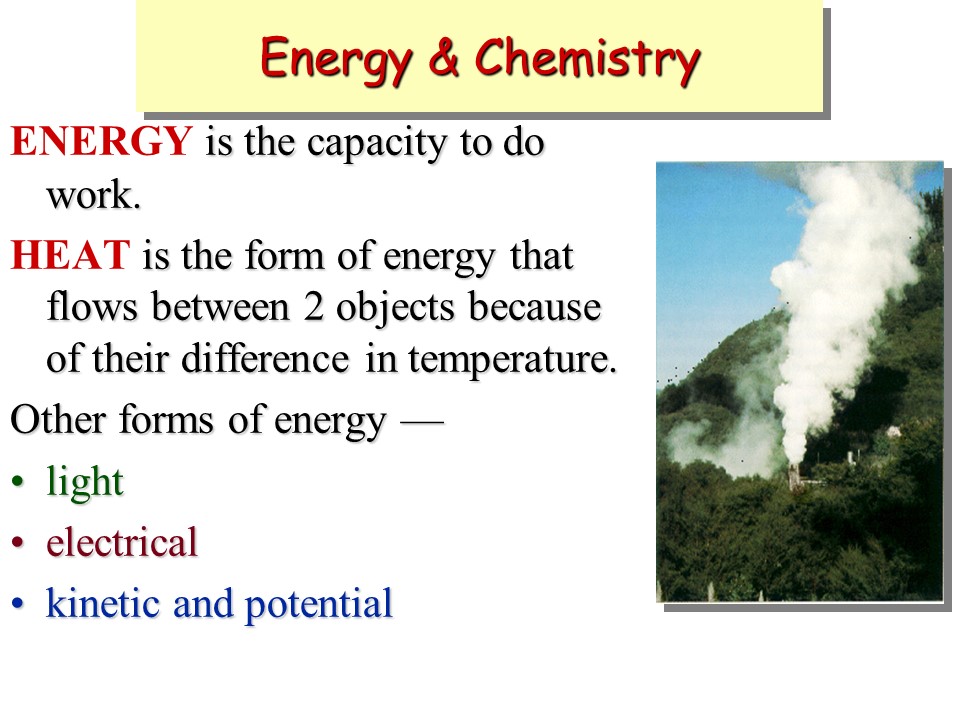Energy - PowerPoint PPT Presentation
Title:
Energy
Description:
Energy & Chemistry ENERGY is the capacity to do work. HEAT is the form of energy that flows between 2 objects because of their difference in temperature. – PowerPoint PPT presentation
Number of Views:116
Avg rating:3.0/5.0
Title: Energy
1
Energy Chemistry
- ENERGY is the capacity to do work.
- HEAT is the form of energy that flows between 2
objects because of their difference in
temperature. - Other forms of energy
- light
- electrical
- kinetic and potential
2
Potential Energy on the Atomic Scale
- Positive and negative particles (ions) attract
one another. - Two atoms can bond
- As the particles attract they have a lower
potential energy
NaCl composed of Na and Cl- ions.
3
Thermodynamics
- Thermodynamics is the science of heat (energy)
transfer.
Heat energy is associated with molecular motions.
Heat transfers until thermal equilibrium is
established.
4
(No Transcript)
5
(No Transcript)
6
Directionality of Heat Transfer
- Heat always transfer from hotter object to cooler
one. - EXOthermic heat transfers from SYSTEM to
SURROUNDINGS.
7
Directionality of Heat Transfer
- Heat always transfer from hotter object to cooler
one. - ENDOthermic heat transfers from SURROUNDINGS to
the SYSTEM.
8
UNITS OF ENERGY
- 1 calorie heat required to raise temp. of 1.00
g of H2O by 1.0 oC. - 1000 cal 1 kilocalorie 1 kcal
- 1 kcal 1 Calorie (a food calorie)
- But we use the unit called the JOULE
- 1 cal 4.184 joules
9
HEAT CAPACITY
- The heat required to raise an objects T by 1 C.
10
Specific Heat Capacity
- How much energy is transferred due to T
difference? - The heat (q) lost or gained is related to
- a) sample mass
- b) change in T and
- c) specific heat capacity
11
Specific Heat Capacity
- Substance Spec. Heat (J/gK)
- H2O 4.184
- Ethylene glycol 2.39
- Al 0.897
- glass 0.84
Aluminum
12
Exercise Specific Heat Capacity
- If 25.0 g of Al cool from 310 oC to 37 oC, how
many joules of heat energy are lost by the Al?
13
Answer Specific Heat Capacity
- If 25.0 g of Al cool from 310 oC to 37 oC, how
many joules of heat energy are lost by the Al?
where ?T Tfinal - Tinitial q
___________________ q _______ J
Notice that the negative sign on q signals heat
lost by or transferred OUT of Al.
14
Measuring Heats of Reaction
CALORIMETRY
- Constant Volume Bomb Calorimeter
- Burn combustible sample.
- Measure heat evolved in a reaction.
- Derive ?E for reaction.
15
Calorimetry
Total heat evolved qtotal qwater qbomb
16
Measuring Heats of ReactionCALORIMETRY
- Calculate heat of combustion of octane. C8H18
25/2 O2 --gt 8 CO2 9 H2O - Burn 1.00 g of octane
- Temp rises from 25.00 to 33.20 oC
- Calorimeter contains 1200 g water
- Heat capacity of bomb 837 J/K
17
Heat TransferNo Change in State
- q transferred (sp. ht.)(mass)(?T)
18
Heat Transfer with Change of State
- Changes of state involve energy (at constant T)
- Ice 333 J/g (heat of fusion) -----gt Liquid
water - q (heat of fusion)(mass)
19
Heat Transfer and Changes of State
Liquid ---gt Vapor
- Requires energy (heat of vaporization). T
remains constant.
energy
20
Heating/Cooling Curve for Water
Evaporate water
Heat water
Melt ice
Note that T is constant as ice melts
21
Heat Changes of State
- Calculate the total amount of heat required to
convert 500.0 g of water at -50.00 oC to steam at
200.0 oC. The heat of fusion of water is 333 J/g
and the heat of vaporization is 2256 J/g. The
heat capacity of ice is 2.06 J/g.K and the
specific heat capacity of steam is 1.92 J/g.K.































